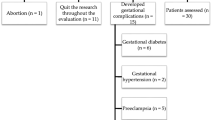Abstract
Objective
Oxidative stress has been implicated in pregnancy-induced hypertension and preeclampsia. There is still some debate over whether this is confined to the placenta or occurs in the maternal circulation. This study was designed to investigate this question by comparing parameters of oxidative stress in samples of maternal blood and cord blood taken from normotensive and hypertensive pregnant women. A further aim was to compare these parameters in maternal milk from the two populations.
Study design
Forty-six hypertensive (31 preeclamptic and 15 chronic hypertensive) and 60 normotensive pregnant women were recruited. Antecubital blood was collected from each woman before and after delivery, cord blood just after delivery, and maternal milk for the first 3 days postpartum. Total antioxidant capacity, total peroxides and sulphydryl concentration were measured and total antioxidant capacity calculated for each specimen.
Results
For all specimens (maternal blood plasma, cord blood plasma, maternal milk) total antioxidant capacity and sulphydryl concentration were significantly lower in the hypertensive women than in the normotensive, while total peroxide and oxidative stress index were significantly higher.
Conclusion
These results support the association between hypertension in pregnancy and oxidative stress and the view that this occurs throughout the maternal circulation. They show further that oxidative stress may be transmitted from mother to newborn in maternal milk. Supplementation with antioxidants could, in view of our findings, possibly provide protection to the mother and fetus and also, through transmission in maternal milk, to the newborn.
Similar content being viewed by others
References
Shaarawy M, Aref A, Salem ME, Sheiba M (1998) Radical-scavenging antioxidants in pre-eclampsia and eclampsia. Int J Gynaecol Obstet 60(2):123–128
Harma M, Harma M, Erel O (2005) Measurement of the total antioxidant response in preeclampsia with a novel automated method. Eur J Obstet Gynecol Reprod Biol 118:47
Gitto E, Pellegrino S, Gitto P, Barberi I, Reiter RJ (2009) Oxidative stress of the newborn in the pre- and postnatal period and the clinical utility of melatonin. J Pineal Res 46(2):128–139
Burton GJ, Jauniaux E (2004) Placental oxidative stress: from miscarriage to preeclampsia. J Soc Gynecol Invest 11:342
Poston L, Raijmakers MTM (2004) Trophoblast oxidative stress, antioxidants and pregnancy outcome—a review. Placenta 25:572
Zhou JF, Wang XY, Shangguan XJ, Gao ZM, Zhang SM, Xiao WQ, Chen CG (2005) Increased oxidative stress in women with pregnancy-induced hypertension. Biomed Environ Sci 18:419
Llurba E, Gratacos E, Martin-Gallan P, Cabero L, Dominguez C (2004) A comprehensive study of oxidative stress and antioxidant status in preeclampsia and normal pregnancy. Proc Radic Biol Med 37:557
National High Blood Pressure Education Program Working Group Report on High Blood Pressure in Pregnancy. Am J Obstet Gynecol, 1990; 163(5 Pt 1):1691–712
Hu ML (1994) Measurement of protein thiol groups and glutathione in plasma. Methods Enzymol 233:380
Sagol S, Ozkinay E, Ozsener S (1999) Impaired antioxidant activity in women with pre-eclampsia. Int J Gynaecol Obstet 64:121–127
Uotila JT, Tuimala RJ, Aarnio TM, Pyykko KA, Ahotupa MO (1993) Findings on lipid peroxidation and antioxidant function in hypertensive complications of pregnancy. Br J Obstet Gynaecol 100:270–276
Lum H, Roebuck KA (2001) Oxidant stress and endothelial cell dysfunction. Am J Physiol Cell Physiol 280(4):C719–C741
Hanna N, Ahmed K, Anwar M, Petrva A, Hiatt M, Hegyi T (2004) Effect of storage on breast milk antioxidant activity. Arch Dis Child Fetal Neonatal Ed 89(6):F518–F520
Buescher ES, McIlheran SM (1992) Colostral antioxidants: separation and characterization of two activities in human colostrum. J Pediatr Gastroenterol Nutr 14(1):47–56
Patil SB, Kodliwadmath MV, Kodliwadmath SM (2008) Lipid peroxidation and antioxidant status in hypertensive pregnancies. Clin Exp Obstet Gynecol 35(4):272–274
Zusterzeel PL, Rütten H, Roelofs HM, Peters WH, Steegers EA (2001) Protein carbonyls in decidua and placenta of pre-eclamptic women as markers for oxidative stress. Placenta 22(2–3):213–219
Yanik FF, Amanvermez R, Yanik A, Celik C, Kökçü A (1999) Pre-eclampsia associated with increased lipid peroxidation and decreased serum vitamin E levels. Int J Gynaecol Obstet 64(1):27–33
Howlader MZ, Parveen S, Tamanna S, Khan TA, Begum F (2009) Oxidative stress and antioxidant status in neonates born to pre-eclamptic mother. J Trop Pediatr (Epub ahead of print)
Kolusari A, Kurdoglu M, Yildizhan R et al (2008) Catalase activity, serum trace element and heavy metal concentrations, and vitamin A, D and E levels in pre-eclampsia. J Int Med Res 36(6):1335–1341
Chappell LC, Seed PT, Briley AL et al (1999) Effect of antioxidants on the occurrence of pre-eclampsia in women at increased risk: a randomized trial. Lancet 354(9181):810–816
Leger CL, Dumontier C, Fouret G, Boulot P, Descomps B (1998) A short-term supplementation of pregnant women before delivery does not improve significantly the vitamin E status of neonates-low efficiency of the vitamin E placental transfer. Int J Vitam Nutr Res 68:293–299
Madazli R, Benian A, Gumustas K, Uzun H, Ocak V, Aksu F (1999) Lipid peroxidation and antioxidant in preeclampsia. Eur J Obstet Gynecol Reprod Biol 85:205–208
Zhang C, Williams MA, King IB et al (2002) Vitamin C and the risk of preeclampsia—results from dietary questionnaire and plasma assay. Epidemiology 13:409–416
Rodrigo R, Parra M, Bosco C et al (2005) Pathophysiological basis for the prophylaxis of preeclampsia through early supplementation with antioxidant vitamins. Pharmacol Ther 107(2):177–197
Chappell LC, Seed PT, Kelly FJ et al (2002) Vitamin C and E supplementation in women at risk of preeclampsia is associated with changes in indices of oxidative stress and placental function. Am J Obstet Gynecol 187:777
Conflict of interest
We declare that we have no conflict of interest.
Author information
Authors and Affiliations
Corresponding author
Rights and permissions
About this article
Cite this article
Erdem, M., Harma, M., Harma, I.M. et al. Comparative study of oxidative stress in maternal blood with that of cord blood and maternal milk. Arch Gynecol Obstet 285, 371–375 (2012). https://doi.org/10.1007/s00404-011-1993-8
Received:
Accepted:
Published:
Issue Date:
DOI: https://doi.org/10.1007/s00404-011-1993-8




